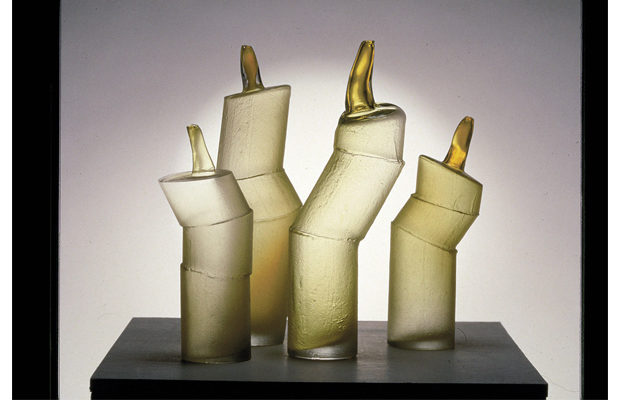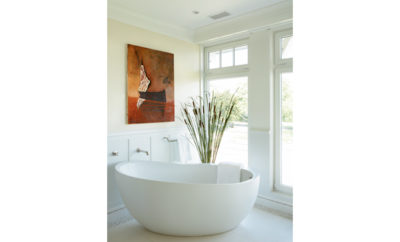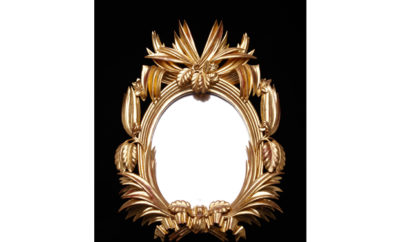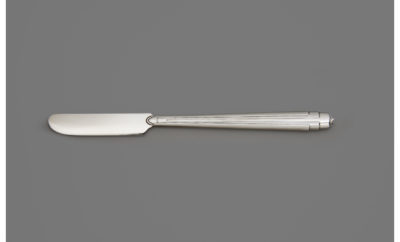
Feature
Vitreous Verve

Joel Philip Myers’s “Dialogue #8” of 1998. The tallest form in the grouping stands 18 ¼ inches high.
Vitreous Verve
A profile of Joel Philip Myers, one of America’s most admired—and collectible—kingpins and innovators in the worlds of commercial and studio glassmaking
Joel Philip Myers is an exuberant artist who celebrates life through his colorful works in glass. Born in New Jersey in 1934, he has enjoyed a nearly fifty-year career and is not only historically important in terms of his role in the development of studio glass, but his work also illustrates the tremendous versatility of glass as a medium for artistic expression.
Myers is among a small handful of pioneers who, beginning in the early 1960s, sought to work with glass in private studios rather than in a factory environment. After studying industrial design at Parsons School of Design from 1951 to 1954, Myers was hired by Donald Deskey Associates. But he disliked the collaborative nature of working on packaging design at Deskey and left in 1957 to study ceramic design at the Kunsthaandvaerkerskolen (School of Arts and Crafts) in Copenhagen. His experience in Denmark was formative and long lasting, not only because of the influence of Scandinavian design but also because it was here that he met his future wife, Birthe, also a student of ceramics.
In 1960 Joel and Birthe both enrolled in the ceramics department at Alfred University in upstate New York. By 1963 Myers’s reputation had grown so much that he was offered the position of design director at the Blenko Glass Company in Milton, West Virginia. The opportunity included not only a job but also a non-traditional route to an MFA from Alfred, as his experiences at Blenko became field work for this degree, which he received in 1968.
While many of his designs were introduced into Blenko’s production lines between 1964 and 1971, he took the position with the intention of using his proximity to the material to develop his own expertise in blowing glass, and he managed to find time on breaks, during lunchtime, and after hours to sneak onto the factory floor and teach himself how to do it. His approach to learning was very matter-of-fact. He watched and emulated.
In 1970 Myers was hired to start a glass program at Illinois State University and from this position in the academic world he observed the activities of other studio glass pioneers such as Harvey Littleton and Marvin Lipofsky. Although he did not attend the now famous Toledo Glass Workshops led by Littleton, and was not a student of his like so many of the first studio glassmakers, Myers interacted with those who had begun to lure glass out of the hands of factory workers and into the hands of independent artists like himself. He invited glass artists to visit Illinois State and traveled to the first conferences where demonstrations of glass blowing were a main feature.
Trained in the more formal world of design, Myers first focused on creating works in glass that were expressive yet also controlled and refined. In his “Hand” series he experimented with sculpting glass, and in his “Dr. Zharkov” series, named after the character in the Flash Gordon comic strip, he challenged the small scale of other early studio works by stacking small shapes together. In some of his first studio pieces, made while employed at Blenko, Myers “painted” with silver luster on translucent vessels. An early chalk study from his Parsons days, however, shows his interest in shapes and colors and foreshadows his future work in glass. His long-lasting artistic voice would be one that expressed his passion for these abstract shapes and eye-catching colors.
Myers developed a technique for his colorful pieces that involved first creating shards by breaking thinly blown pieces. The shards were then arranged in a type of collage, and, while the glass was still in its molten state, the fragments were adhered to the surface of a vessel as it was blown. In this way glass became Myers’s canvas. His forms are subtle, forcing attention to the treatment of the surface of the object. He seeks for continuity in his work without repetition and his exploration of color and evolution of shapes developed in a parallel progression; the vessels evolving from vertical to rounder to elongated, each new shape offering a new sort of canvas.
An avid gardener and fly fisherman, Myers translates his passion for nature into a riot of vibrant colors in “Valmuen XXXX1” and “Red Fish,” both part of his “Contiguous Fragment” series, which he initiated in 1977 and deliberately concluded in 1993. His foray into opaque glass, both black and white, resulted in vessels that look more like ceramics than glass, challenging the notions of what glass ought to look like.
He took a significant leap away from his abstract colorist approach in the 1990s, experimenting with molds to create cylindrical shapes for his “Color Study” and “Dialogue” series. In a serious and contemplative move he made “Ghosts of War” after spending a period of time studying World War I. He eventually returned to shapes and colors, this time pushing his forms even more forcefully into the role of canvas. In 2001 Myers began his “Canvas” series. He created more surface space for himself by flattening his vessels into four-sided objects. The fragmented “paintings” could now play out in a continuation at each turn of a corner.
As an artist Myers considers himself a “visitor in a maze, trying to find a solution to a dizzying puzzle.” Within that maze he explores, blunders, arrives at solutions. It is here that he embraces the possibilities of glass and is “sensitive to the wonders of the visual world, inspired by the forms and colors of the natural world.” A recipient of the Craftsman’s Fellowship from the National Endowment for the Arts and represented in museum collections around the world, Joel Philip Myers’s contributions to the studio glass world both in terms of his body of work and his dedication as a teacher are to be admired and deeply appreciated. His work not only illustrates his zest for life and provides a glimpse into his intuitive and emotional self, but it also confirms that this seemingly utilitarian material, in the right hands, has endless possibilities for expression and beauty.












